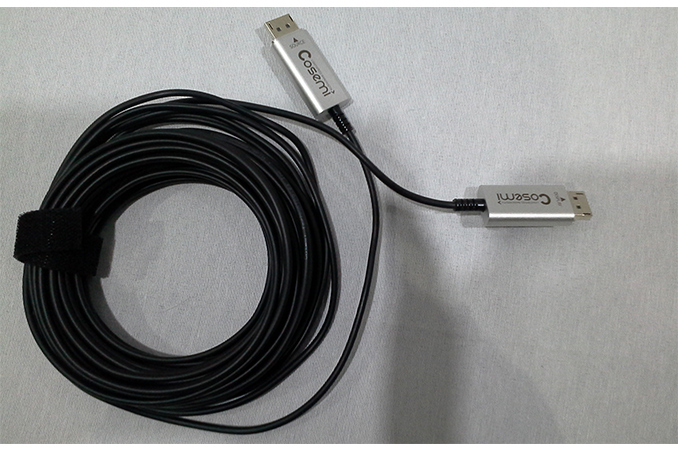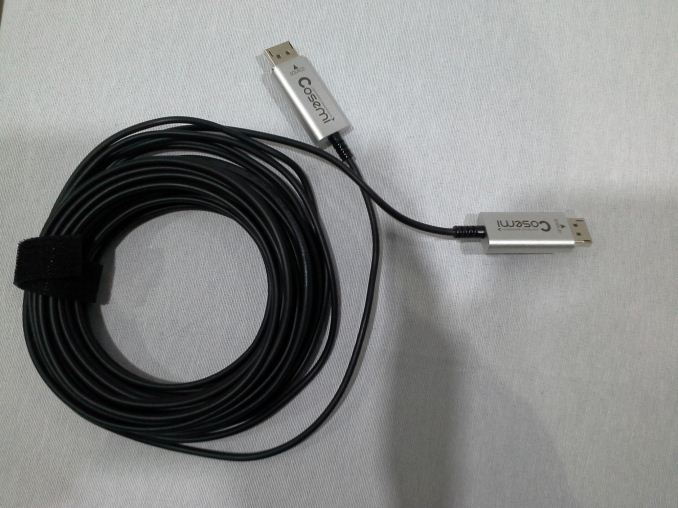Cosemi Announces 328-Feet ‘8K-Ready’ OptoDP Active DisplayPort 1.4 Optical Cable
by Anton Shilov on March 29, 2017 3:00 PM EST
Cosemi has announced its first OptoDP active optical cable that supports a DisplayPort 1.4 connection. That in itself isn't newsworthy, but up to 328 feet, or 100 meters, it seems rather interesting. The cable supports resolutions up to 8K60 4:4:4 at 60 Hz and is designed for users who need to connect ultra-high-definition displays/TVs or projectors to sources located far away.
Compared to DP 1.3, which supports up to 4Kp120 and 8Kp30, DP 1.4 can enable Display Stream Compression 1.2 and Forward Error Correction, despite no difference in bandwidth between the two standards. This allows DP 1.4 hardware to support 7680×4320 resolution with 4:4:4 chroma subsampling at 60 Hz with 10-bit color and HDR (as well as 4Kp240) over a ~25.92 Gbps interconnection. Cosemi’s OptoDP active optical cable guarantees DP 1.4 signal integrity at the length of up to 100 meters without any additional external power.
Cosemi demonstrated the work of its cable with 8Kp60 resolution at the Optical Fiber Communication Conference and Exhibition (OFC), with the National Institute of Information and Communications Technology (NICT) and TechnoAP. Keep in mind that the showcase was focused on demonstration of signal integrity and not on an actual 8Kp60 display with appropriate content.
| OptoDP Active Optical Cable Key Features | |||
| Cosemi OptoDP1.4 | |||
| Material | High-Speed Fiber Optics | ||
| Bandwidth (theoretical/actual) | 32.4/25.92 Gbps | ||
| Maximum Resolution | 7680×4320 resolution with 4:4:4 chroma subsampling at 60 Hz (with DSC enabled) |
||
| Length | 100 meters/328 feet | ||
| DisplayPort Version | 1.4 | ||
Technically speaking, there are DisplayPort 1.3-compliant active optical cables supporting up to a ~26 Gbps bandwidth. However, Cosemi’s cable is extremely long and the company has demonstrated that it works. Before coming to a commercial product, the cable will actually get an official DP 1.4 certification.
Cosemi said that it would start production of OptoDP active optical cables shortly. In addition, the company is prepping an active optical USB Type-C cable that would enable DisplayPort 1.4 over USB-C interconnections at long distances. The manufacturer said nothing about pricing of its cables, but given that we are talking about a 100-meter active optical solution for prosumers as well as cinemas, they will everything but cheap. For example, a 30-meter active optical DP 1.3-compliant cable retails for $799.99.
Related Reading:
Source: Cosemi











22 Comments
View All Comments
DanNeely - Wednesday, March 29, 2017 - link
Probably a stupid question, but looking at the theoretical/actual bandwidth numbers it's clear that DisplayPort is still only using 8/10 bit encoding. Why haven't they switched to a more efficient one like 128/130 that would reduce the encoding overhead from 20% of the total bandwidth to 1.5%fanofanand - Wednesday, March 29, 2017 - link
That's DisplayPort 1.5.Kidding (sort of) but that's a good question, I would like to know this as well.
blahsaysblah - Wednesday, March 29, 2017 - link
Disappointing. DP1.3 and DP1.4 only have actual raw bandwidth for around 4k@90 with 10 bit colors. Anything beyond that is through the mathematically LOSSY DSC/Display Stream Compression feature. DP 1.4 really only added features for TV/movie watching. It is not for gamers, it is not for professionals. It does not deliver your actual pixels.Insane to pay $5k for an 8K TV and the insane price this cable wants, just to not get your actual pixels.
cbm80 - Wednesday, March 29, 2017 - link
DSC doesn't add significant latency. It's fine for gaming.willis936 - Thursday, March 30, 2017 - link
A lot of games don't do well with bitrates less than 100 Mbps because of how fast the motion is. That's hardly an issue when we're talking about squeezing 120 Gbps into a 40 Gbps link. Display compression is where display industries are headed because it's not worth it to make a stupidly expensive interconnect just to keep up with display resolution.Etsp - Thursday, March 30, 2017 - link
The encoding overhead is for forward error correction (FEC). Decreasing the FEC overhead means that to reliably decode the signal, the signal quality needs to be higher. Going from 8/10 to 128/130 means it needs to be MUCH higher.To achieve that requires more expensive and thicker cables with better shielding, shorter maximum cable lengths, higher signal power transmitted over the cable, or other tradeoffs.
HarrietTheGuy - Saturday, April 1, 2017 - link
8b10b is not FEC. Its for DC line balancing and guaranteeing enough transitions to lock onto the signal. As well as having extra control characters for alignment.BrokenCrayons - Wednesday, March 29, 2017 - link
Only $800? Best Buy is not impressed.solipsism - Wednesday, March 29, 2017 - link
Wow! People are complaining that a 100 meter DisplayPort cable costs too much. If you need this cable, then the cost isn't going to be an issue.p1esk - Wednesday, March 29, 2017 - link
People are complaining because you can buy 30m 40Gb Cisco optical cable for $180: http://www.fs.com/products/40098.html